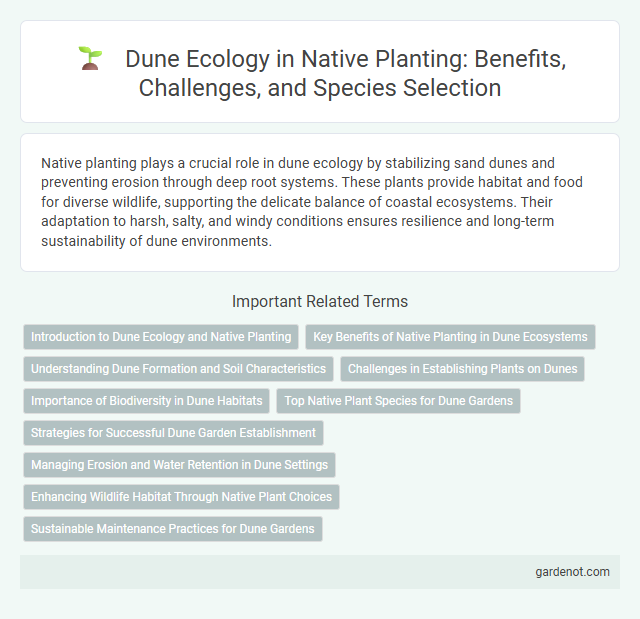Native planting plays a crucial role in dune ecology by stabilizing sand dunes and preventing erosion through deep root systems. These plants provide habitat and food for diverse wildlife, supporting the delicate balance of coastal ecosystems. Their adaptation to harsh, salty, and windy conditions ensures resilience and long-term sustainability of dune environments.
Introduction to Dune Ecology and Native Planting
Dune ecology encompasses specialized plant communities adapted to sandy, nutrient-poor, and saline environments along coastlines. Native planting in dune ecosystems involves selecting indigenous species such as Ammophila breviligulata (American beachgrass) and Hudsonia tomentosa (beach heather) to stabilize sand dunes and enhance biodiversity. These native plants play crucial roles in dune formation, erosion control, and providing habitat for coastal wildlife.
Key Benefits of Native Planting in Dune Ecosystems
Native planting in dune ecosystems stabilizes sand dunes by anchoring soil with deep root systems, reducing erosion and protecting coastal landscapes. These plants enhance biodiversity by providing habitat and food sources for specialized wildlife, including native insects and birds. Their adaptation to harsh saline, wind, and nutrient-poor conditions promotes ecosystem resilience and natural dune regeneration.
Understanding Dune Formation and Soil Characteristics
Dune formation results from the accumulation of sand particles transported by wind, creating distinct ridges shaped by vegetation that stabilizes the loose substrate. Native plant species, such as beach grasses and shrubs, play a crucial role in anchoring sand with their root systems, enhancing soil cohesion and preventing erosion. The soil in dune ecosystems is typically sandy, well-drained, nutrient-poor, and prone to salt spray, requiring specialized adaptations from native plants to thrive in these harsh conditions.
Challenges in Establishing Plants on Dunes
Establishing plants on dunes faces challenges such as unstable, sandy substrates that hinder root anchorage and water retention. Harsh conditions like salt spray, high winds, and limited nutrient availability further stress native vegetation. These factors demand resilient, specially adapted species and targeted restoration techniques to ensure successful dune plant establishment.
Importance of Biodiversity in Dune Habitats
Dune habitats support a diverse array of native plants and animals uniquely adapted to harsh, sandy environments, making biodiversity crucial for ecosystem resilience. Native plant species such as beach grasses and dune wildflowers stabilize sand dunes, preventing erosion and promoting habitat complexity. High biodiversity in dune ecosystems enhances nutrient cycling, supports pollinators, and provides critical shelter for wildlife, maintaining the ecological balance necessary for dune sustainability.
Top Native Plant Species for Dune Gardens
Seaside goldenrod (Solidago sempervirens) and beach grass (Ammophila breviligulata) are top native plant species essential for stabilizing dune ecosystems due to their deep root systems that prevent erosion. American beach grass thrives in sandy, salt-tolerant environments, promoting dune formation and resilience against wind and wave damage. Sea oats (Uniola paniculata) also play a critical role in dune ecology, supporting habitat diversity while anchoring the sandy soil effectively.
Strategies for Successful Dune Garden Establishment
Establishing a dune garden successfully requires selecting native plants with deep root systems such as American beachgrass (Ammophila breviligulata) and sea oats (Uniola paniculata) to stabilize shifting sands and prevent erosion. Incorporating a mix of salt-tolerant species like seaside goldenrod (Solidago sempervirens) and beach pea (Lathyrus japonicus) enhances biodiversity while improving soil health and moisture retention. Strategic planting in staggered rows and maintaining minimal disturbance replicates natural dune succession, fostering resilient ecosystems that withstand harsh coastal winds and salt spray.
Managing Erosion and Water Retention in Dune Settings
Native planting in dune ecology stabilizes sandy soils by establishing deep-rooted vegetation that reduces erosion and enhances water retention. Species such as beach grass and sea oats create dense root networks, minimizing soil displacement during wind and water events. Effective management integrates native plants to improve dune resilience, promote habitat diversity, and maintain coastal protection.
Enhancing Wildlife Habitat Through Native Plant Choices
Native plants in dune ecosystems provide essential shelter and food sources for local wildlife, promoting biodiversity and ecological resilience. Selecting native species like beach grass, sea oats, and dune sunflowers stabilizes sand dunes and supports pollinators, birds, and small mammals. These native plant choices create a sustainable habitat that fosters natural wildlife populations and improves ecosystem health.
Sustainable Maintenance Practices for Dune Gardens
Sustainable maintenance practices for dune gardens emphasize the use of native plant species that stabilize sandy soils and enhance biodiversity. Regular removal of invasive species ensures the health and resilience of dune ecosystems, promoting natural regeneration and erosion control. Minimal irrigation and organic mulching support water conservation, aligning with the ecological balance of coastal dune environments.
Dune ecology Infographic

 gardenot.com
gardenot.com